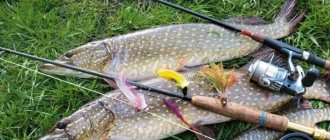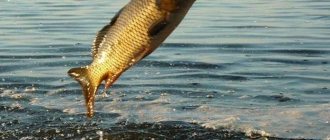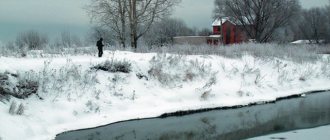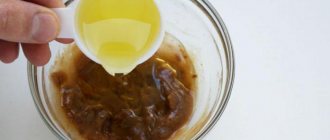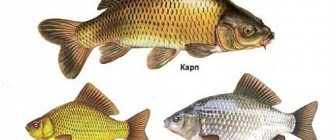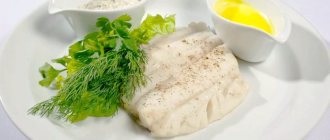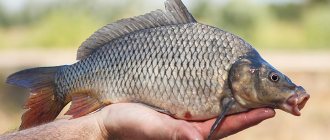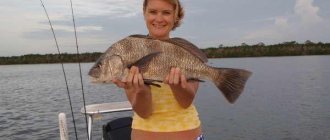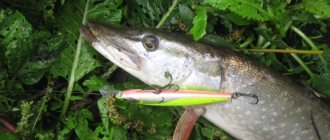Carp belongs to the carp family. There are three varieties: mirror, scaly and naked, its wild relative carp. Lover of warm waters, lakes, calm rivers, ponds. It is bred as a commercial fish. Carp grows quickly and, under good conditions, by the second year of life it gains weight up to 600 grams. The maximum weight is 6-8 kg, but there are specimens up to 12 kg. The fish is omnivorous and unpretentious, which is why it is popular among fishermen. But there are nuances that at times make this simple fish very capricious and cautious.
Change in bite depending on the season
In winter , due to lack of oxygen, carp are passive and practically do not bite. It overwinters in deep water holes without moving, preserving the energy accumulated over the summer. There are cases of winter fishing, but more often carp are caught on the hook.
In spring, the fish are lethargic, do not bite and are preparing for spawning. There are two weeks before spawning, when the bite appears, but not for long. Starting in April, when the trees bloom, the first activity appears. There is little food, but I want to eat. The peak of good fishing occurs at the end of April and beginning of May. It develops a zhor, the carp gains weight and strength, and is very active. Then there is a short break. After spawning at the end of May, the carp rests and gains strength.
In summer , carp bite unevenly. At this time of year there is a lot of plant food that he loves, there are many fishermen with a variety of food, there is plenty to choose from. But this does not mean that you cannot catch carp in the summer. It is worth paying attention to the lake and river, the place where carp are caught and the number of fishermen with a whole arsenal of different bait. Maybe in another place the fish is boring and doesn’t want to bite, but in another place it bites on any bait. Only through experience in the summer can one find a place for good fishing.
In autumn , when it gets colder, the fish becomes lethargic and inactive, and the metabolism slows down. But as soon as the sun warms up, she tries to gain “fat,” but there are almost no greens and larvae. And the hungry carp begins to peck everywhere and on everything, accumulating strength and energy for the long winter. In regions with early winter, this time falls at the end of August - beginning of September. In areas with warm autumns and warm winters, the period shifts to mid-September and continues until mid-October. This is interesting. A popular legend says that the spawning of carp coincides with the flowering of wheat. And it blooms in stable warm weather within two to three weeks.
Fishing in November on a feeder
The feeder is a long-range tackle that allows you to cast up to 100 meters or more. This is important when fishing for autumn carp during the period of open water with the onset of cold weather. The use of dump truck feeders allows you to deliver bait to predetermined places that are promising for fishing.
To fill the feeder, you can use homemade carp porridge, or it is easier to purchase industrially produced “plasticine”. In November, when there is a decrease in fish activity, it is better to equip the feeder with several feeders or springs, 4-6 cm long and 1-3 cm in diameter.
It should be taken into account that in late autumn the probability of biting large fish increases. The carrying capacity of the fishing line (cord) must ensure that the intended catch can be caught. You need to focus on the carp living in the reservoir. To catch specimens weighing 2-5 kg, it is enough to install a high-quality fishing line of 0.2 mm. Carp in November are unlikely to be tempted by bait on rough equipment. The thickness of the fishing line (cord) should be selected according to the principle of necessary sufficiency. The coil plays an important role in the feeder equipment. High-quality types of fishing hooks are selected.
What do carp bite on in November?
It is difficult to answer the question unambiguously: what do carp bite on in November? When preparing for carp fishing at the end of autumn, it is advisable to give preference to bait of animal origin: worm, maggot. Although practical carp fishing in November shows that it often bites on plant baits. You can make boilies yourself or buy them at a specialty store. This is a delicacy for carp at any time of the year.
It is necessary to check the reaction of the fish to all baits and plant attachments available in the arsenal. But it is not a fact that after biting a worm, the carp will not be tempted by the fragrant boilie.
When fishing for carp in November, you should not expect quick results. It is important to study the bottom surface in detail and identify several promising places in advance. Frequent changes of place and quick recasts do not contribute to successful fishing. It is better to use several tackles at the same time, which are thrown into different areas. The main thing is to take care of their reliable fastening on the shore.
Conditions for the best bite
- Times of Day. Carp is considered a nocturnal fish; it is at this time of day that it is active. In the evening, he also likes to eat, but this does not mean that fishing will be unsuccessful at lunchtime. It bites well at early and evening dawn. In cool weather, fishing during the day is preferable to night fishing. In autumn, successful fishing occurs closer to noon, when the water warms up enough.
- Atmospheric pressure and weather. Carp are sensitive to pressure changes and this nuance should be taken into account when going fishing. High pressure entails a decrease in oxygen in the water, which means the fish will be lethargic and will not bite. This happens in warm weather. Low pressure occurs in cloudy, windy and rainy weather. They, in turn, fill the reservoirs with more oxygen. Therefore, carp fishing is always successful during rain, thunderstorms and wind, or in cloudy but not hot weather. Any carp fisherman will endure rain and wind, but will have a good catch. But if the rains are prolonged, the bite stops until stable weather sets in. Conclusion: Successful fishing will be at atmospheric pressure below 750 mm. rt. Art. Failure to catch carp will occur above 770 mm. rt. Art.
- Temperature. Carp is a heat-loving fish, the optimal water temperature at which it is active is + 19-25. Spawning takes place at +16-19 degrees, and the fish wakes up at +7. As soon as the temperature drops, the carp looks for warmer places and moves to shallow water, where the water warms up better. In spring, a good bite begins at + 14-16, the fish are hungry and bite well.
- Fishing place. The most favorite habitats of carp:
- Lakes and ponds with muddy water.
- Snags, holes with uneven bottoms.
- Thickets of water lilies.
- Banks with overhanging trees.
- Seaweed carpets.
Carp prefers warm lakes and ponds with cloudy water. Likes to live in deep places next to snags, shallow water with a grassy bottom. In the spring, it is found near the mouth of the river, where there is a lot of food, but in the summer it sits out in holes with an uneven bottom. On warm summer evenings, carp come out to the sandbanks, and in the spring it is good to catch them in shallow water, where the water warms up well.
Most often it lives in ponds and lakes with weak currents, and even better in standing water.
The bottom prefers muddy, maybe hard, but not rocky. Successful fishing will be on the shore with overhanging trees. Such places seem safe to the cautious carp, and he feeds there fearlessly.
Carp love places overgrown with carpets of algae. There is a lot of food in them, he is safe there. Fishing in this place is problematic, but if the carp angler is patient, he will get a good catch.
Thickets of water lilies are also a favorite place for carp; they provide them with food and shelter. But between the windows of wide leaves, it is convenient to place the bait. And try not to make noise so as not to scare the fish.
Features of carp fishing in November
Carp biting in November is possible day and night. But it should be remembered that changes in weather conditions affect the behavior of this fish. As the water temperature drops to +8 degrees, large individuals weighing over 10 kg move to wintering pits and stay in these areas until freeze-up occurs. Although this does not mean that the voracious fish stops searching for food.
In November, carp moves at depth and feeds on the remains of vegetation and bottom insects that do not yet have time to burrow deeply into the silt. On calm days with above-zero air temperatures, the freshwater giant becomes more active.
In late autumn, the question remains controversial: is bait needed for carp during this period? The use of bait will not be superfluous, since it is impossible to overfeed a carp that has become fat during the warm season. Even at fishing bases, where it receives a sufficient amount of food, the flagship of its own carp family does not refuse the offered bait.
Carp fishing in November is carried out mainly from the shore, but in the southern regions, fishing using a boat is still available at the beginning of the month. On large reservoirs in relatively warm weather, it is still possible to catch carp with mugs. Practice shows that the most effective way to catch carp is in the fall using a feeder. The main thing is to figure out how to choose a feeder rod.
Dependence of the bite on the gear and bait used
You can catch carp on the shore or from a boat. The tackle must be strong and durable. The fisherman must be able to control it. Carp is a gambling fish, strong and cunning. He can immediately break the rod or drag the fishing rod along with him. He has the power to bend or break a hook, even break a strong fishing line. Therefore, the gear must be strong and at the same time not rough; the carp sees them and avoids them. Whatever the line stands out in the water, it must be green and the float is not bright, otherwise the fish will get scared and leave.
The most suitable tackle is a spinning rod with a reel, a vein diameter of 0.4-0.6, a single hook with a number from 6 to 10, with a short shank. In summer it is convenient to catch fish with bottom tackle and a float rod for catching carp, in spring with a donka from the shore and a boat.
Carp eats everything and has a well-developed sense of smell and taste to search for food. It feeds at the bottom of a river or lake, loves deep holes. Its diet is dominated by:
- Worms.
- River mollusks.
- Various larvae.
- Seaweed.
- Seeds of aquatic plants.
- Caviar of frogs and small fish.
It is good to feed the fish with corn, boiled potatoes, corn flour, bread with vegetable oil, chopped worms, and everything that will be used for bait.
Various grains are suitable for the nozzle. Rye, wheat, barley, and corn are steamed in sweetened and salted milk. Choose large grains and place 2-3 grains on a hook.
If in summer the carp prefers plant food, then in the fall it bites on nutritious, animal bait. Therefore, it is worth adding chopped earthworms, maggots, and bloodworms to the porridge.
This is interesting: Carp have a well-developed sense of smell, and in the cold season it is good to add an unusual and persistent flavor to the complementary food and bait that will attract the fish. It could be cinnamon or vanilla.
How to catch carp in autumn
When fishing for carp in autumn, the main difficulty is choosing a promising place. In order not to leave the reservoir without a catch, you need to find the ideal area where the fish live. It is often found near large shallows, with plenty of food and warm water. Carp especially loves heavily overgrown or snagged places, as well as areas with a relief bottom and sharp changes in depth. Schools of small carp are found at depths of 1.5 to 5 meters, as well as in places where streams pass into the river.
Effective fishing involves choosing several fishing points located at a short distance from each other. After making several reconnaissance casts, you need to select a promising depth at each point.
These points can be located:
1. At exits from pits or depressions; 2. In the shell rock zone; 3. In the thickets of reeds;
Having properly fed such areas, you can start fishing, gradually changing the casting point and moving from one to the next. When fishing in autumn, we must not forget that carp is a very cautious fish. Seeing prey, he will think carefully before swallowing it.
If the carp doesn't bite
In order for the fish to bite, it is advisable to feed it with porridge or earthworms for several days. But complementary foods, as well as the bait, must change. All kinds of porridges, worms, steamed grain, macadamia are used; it’s worth trying boilies, which carp take well.
During spawning, you should not expect a bite ; the fish does not think about food, but about the future offspring and is very cautious. But after spawning, it’s time to eat. Maybe it’s worth changing the feeding place for a while, and then returning to it. After a short break, the carp returns here.
It is worth taking a closer look at the topography of the reservoir, observing the lake to see if there are carp here at all. Don't hesitate to ask local carp anglers what they use to catch carp. If the gear is not selected correctly, it will affect the carp’s bite. Therefore, the selection of equipment must be approached specifically. We need to try several options for replacing gear.
Carp does not like noise, sudden movements, or strong splashes of water. Fishermen dressed in bright clothes scare him. Therefore, when carp fishing, you should not wear clothes of red, orange, or bright green colors. It is good to fish in silence, alone, in dull clothes.
You should not expect a good bite in places where electric fishing rods or explosives were used, if boric acid was added to the complementary food. Karp remembers everything and will not return to this place.
You shouldn’t fish in hot weather and strong winds; they don’t like calm either. Windy, cool weather with low pressure is the key to successful fishing.
Regarding flavors. A well-chosen and liked smell attracts carp well and works both as complementary food and as bait for a long time.
Carp fishing techniques and tactics
For fishing to be successful, you should follow a few simple rules on fishing techniques and tactics:
- Before you start fishing, you need to study the place.
- Fish requires constant feeding, otherwise it may simply go elsewhere in search of food.
- If there are no results at a certain place, then it is better to change it.
- On the shore, there is no need to make unnecessary sounds so as not to scare away the future catch. Clothes should not be too bright. You should also carefully consider the choice of gear palette.
- It is recommended to take a lot of different baits and lures with you.
Blitz tips
- The best fishing occurs at the end of May, early summer, late September and early October.
- It is good to catch carp at evening and morning dawns.
- At low pressure, in cloudy weather, with little wind, rich fishing is guaranteed.
- Low temperatures force the carp to conserve energy; it will not bite. Active at +20-26.
- Loves quiet, muddy bodies of water, with thickets of ponds, water lilies, banks shaded by trees, and snags.
- Tackle must be selected carefully for complementary foods and baits.
- Consider the fish diet depending on the time of year.
This is interesting: Experienced fishermen have a sign. If there is crucian carp in a lake or pond, then carp will always be nearby.
Feeding carp in autumn
Feeding of the chosen place is carried out several days before fishing. As bait, you can use various homemade and branded store-bought mixtures. To begin with, you can use bait based on grain crops, including corn, hemp, tiger nuts, peas and others. You can add some boilies to the mixture, which will enhance its aromatic properties.
On the following days of complementary feeding, the amount of formula can be reduced. It is also better to use large pieces of bait to attract large fish and scare away small individuals.
And finally, you need to throw some hemp and a fairly large number of boilies into the pond.
Lure
Catching carp without bait is almost impossible. Since it is the complementary food that should show the carp the way to the fishing bait. With the onset of autumn, the amount of complementary foods should be small.
Groundbait, both store-bought and homemade, must contain animal components.
Before you start, you need to do the starting feeding, and you can calmly set up the equipment. During this time, the fish will have time to smell the seductive aroma and swim to the fishing spot. For the first feeding of carp in the fall, a pair of bait balls per tackle is sufficient (if there are 5 tackles, then 10 balls are thrown). several balls of bait the size of a tennis ball for one tackle. Five tackles - 10 balls.
You need to try to cast exactly to the same place, so that the bait is concentrated in one place. This will increase the chances of a bite. Complementary foods can be either purchased or prepared independently. It must contain animal components - crushed worms, small bloodworms, pieces of maggots.
You can make complementary foods more attractive with the help of flavors or dips. It is important not to overdo it with scents. They, of course, should also have animal odors.
If you follow all the rules, the fall carp bite will not take long to arrive
In conclusion
In summer, carp have a good appetite both day and night (moreover, sometimes night bites, given elevated temperatures, are even better than daytime bites). In cold seasons, the best option is to fish during daylight hours. Some carp anglers even take into account the phases of the moon, since it is believed that when it “grows”, things will go better. However, the most important factors, sometimes immediately influencing the bite, are: pressure, wind and weather changes. And, of course, our valuable experience! Thanks to which, you can plan a good fishing trip or find a solution on how to get out of even the most difficult situations “without losses.”
